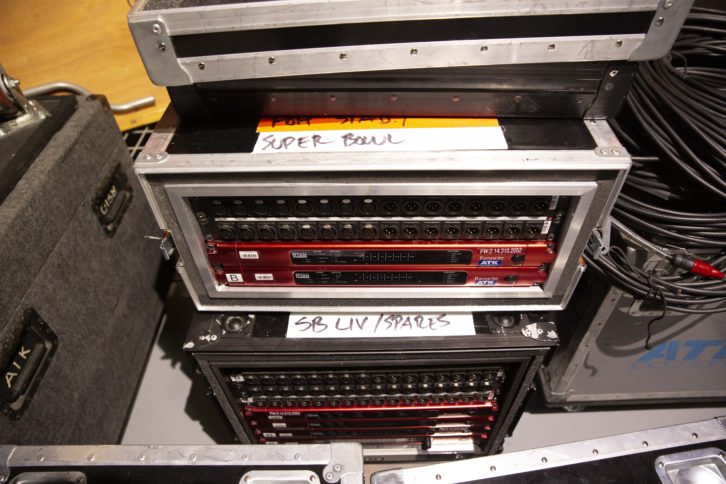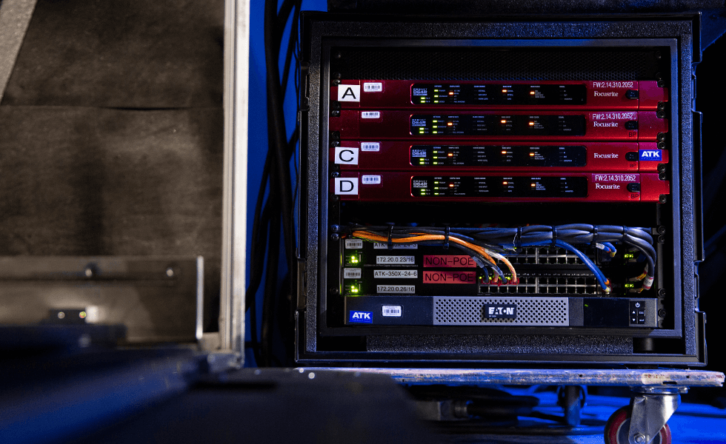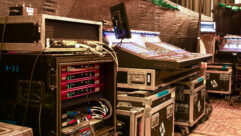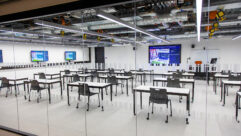Photos by Chris Mayes-Wright / Focusrite

With an estimated 100 million viewers and per-minute advertising costs upwards of $10 million, the Super Bowl is a high-stakes, big-budget event that attracts viewers of all types, with its mix of sports, entertainment and pageantry. The Super Bowl audio has to rise to suit.
Not only is it the biggest game in the National Football League (NFL) calendar, the Super Bowl’s halftime show is one of the entertainment industry’s highlights of the year, with artists pulling out all the stops to deliver career-defining performances. Prince’s unforgettable ‘Purple Rain’ during a tropical downpour in 2007; Beyoncé’s jaw-dropping 2013 ‘Formation’ dance troupe and Michael Jackson’s 1993 medley in Pasadena were all spectacular and critically acclaimed halftime shows.
But staging one of the world’s largest sporting events simultaneously with a once-in-a-lifetime stadium concert presents tremendous challenges. Responsible for all audio aspects of the Super Bowl is ATK Audiotek, a production company based in California, who also have the audio design contracts for other major events including the Academy Awards (the Oscars) and the Grammy Awards. Leading the Super Bowl operations for ATK is Kirk Powell, whose work on the project begins in June of every year.
The Super Bowl occupies a new location every season, and each hosting stadium presents its own set of challenges to the audio system design team, as ATK’s Alex Guessard remarks. “The obvious thing, audio-wise, is the acoustics in the stadium, which have a lot to do with whether it has a roof, no roof, or a partial roof.” They also take into consideration the in-house sound system. “Some stadiums have a decent system, others are older and more bare-bone.” The Super Bowl being the spectacle it is, ATK brings in substantial sound reinforcement to bolster the existing rig, even when the house system is well appointed.
The (Enormous) System
Powell provides an overview: “We have essentially two audio systems each year: the in-house system and the entertainment system. This year the in-house is a flown system. The entertainment system consists of a flown system and our field cart system. We have equipment up in the catwalks and down on the field. Then there’s the mix positions, which vary year to year too, dependent upon where the equipment and our teams are located. Sometimes they’re far away and we have to run fiber to them, and the easiest way to do that is obviously through a network. This year we have a lot of things spread out around the stadium. So we have more nodes than we normally do.”

The Hard Rock Stadium in Miami Gardens is one of the smallest in the League, so space is tight to meet the minimum 70,000 seat capacity required by NFL rules. “Because it’s a smaller stadium and they want less seat kills,” says Kirk, “our positions are not as convenient to get to, especially cable-wise. And therefore we need longer cable runs to get to all our nodes. That’s where having the Dante network comes in to play.”
In addition to the two large-scale sound systems in the venue, ATK provide and operate the substantial backbone of routing equipment and input/output interfaces to patch all the systems together, and allow audio to flow from inputs to mix positions, to amplifiers and speakers, and also to external partners such as broadcasters and recording trucks.
Kirk summarises, “one way to think about it is that, if you’re sitting inside the bowl, what you’re hearing is us. If you’re sitting at home, you’re hearing somebody else’s mix, but that doesn’t mean the feeds are not coming through us to them — a good amount of the sound you hear will be either originating from us or just passing through our audio network. We do some transport, but we also originate a lot of feeds. For instance, the referee mic is our microphone. Literally our microphone. If you hear the referee mic anywhere, it’s coming from us. We’re the only ones that create it. But we give it to the world.”
First Steps
Once the structure of the system is plotted out, the time comes to configure the equipment, a task done by Alex Guessard in the ATK shop, utilising a 50’x50′ space in California. “First, we reset the devices and put the new configuration in them.” Updating firmware, naming channels and making subscriptions on RedNet devices is a straightforward task, thanks to Dante Controller and RedNet Control. But with 70+ units, it’s still a task that needs a methodical approach. “It’s just so much easier to do it in the 50′ by 50′ than try to do that inside the stadium, where it takes you half an hour to go from one area to the other.”
Kirk adds, “in the shop, you can verify the patch is working by just running a 10-foot cable. It’s so much easier than having to walk to the catwalk and back down again, just to check a cable or connection.” Once the whole stadium worth of equipment is configured and operational in one place, the deployment process is as simple as positioning the racks and connecting the fiber or network cables.
By the time the system is deployed throughout the venue, the ATK team is still working on educated assumptions based on best guesses and years of experience. They don’t get the final channel breakdown from the performers or broadcasters until a week before the show (often with changes being made even later). When designing the system, Kirk and Alex generally overestimate, to provide valuable wiggle room if and when last-minute requests come in. Kirk explains, “we have a general idea upfront of what each person needs. But just because that person has requested eight channels, I don’t want to give up just eight channels. I want to have the flexibility to give them more. If they say, ‘you know what, I need two more channels,’ we need to be able to make it work, quickly.”

Before switching the Super Bowl to a 100% networked audio system using Dante in 2019, the ATK team were reliant on systems like CobraNet, which was one of the first networked audio platforms, but which lacked the ability to patch audio around, once addressed. Kirk recalls, “getting into RedNet and Dante really opened up a world to us and allowed a huge amount of flexibility to come out.”
In their cutting-edge setup, ATK racks are positioned in nearly every corner of the stadium. Columns of input and output interfaces, amplifiers and network switches activate all over the stadium. In each position, RedNet units are performing various operations. Nodes at grass-level, at each corner of the field, comprise RedNet MP8R, RedNet A16R and RedNet D16R units, giving Kirk and the ATK team a generous compliment of analogue and digital I/O, plus mic preamps, all a short cable run away.
External Hand-Offs
Also within the ATK remit is interfacing with the various broadcast trucks and mobile production facilities on site. Using RedNet D64R 64×64 Dante to MADI interfaces, Kirk and Alex have devised a standardised way of interfacing with all of these external partners. Super Bowl 2020’s broadcast network is Fox, whose truck is parked adjacent to the stadium. Then there are other mobile production facilities, each responsible for aspects of the event, and each requiring a different profile of audio inputs and outputs. Not all of these external players are Dante enabled, and even if they were, patching them into the already vast ATK network would not necessarily be the most effective way of sending them audio. So these trucks rely on MADI, fed to them via RedNet D64Rs, to transport the audio channels they need into and out of their isolated production environments.

The benefits of keeping external components isolated go beyond keeping the central Dante network simple. With this ‘island’ topology, all parties can be responsible for the clocking of their respective digital audio systems. Alex Guessard explains, “The RedNet D64Rs are really good because they allow us to create different islands.” Kirk adds, “under normal circumstances, it would make sense for the entertainment truck [the NEP Denali] to be the clock master for the entertainment portion. But they’re done after halftime; they’re literally powering down and shutting the doors. So I can’t rely upon them for clock for the rest of the event. So at that point we need to be floating.”
The ‘floating’ solution to this is for each island (or truck) to supply clock via BNC — at whatever sample rate they choose — to the RedNet D64R responsible for transporting their respective MADI signals. On-board sample-rate conversion in each D64R allows for the MADI channels to be transported at a different sample rate and clock source from the Dante Grand Master. Using the D64Rs as the buffer between each external island provides peace of mind and ultimate flexibility to the ATK team and all the broadcast partners.

The Patchmaster
Possibly the most important human aspect to the audio system is the role of Patchmaster, which is a task handled by Luis Montes. Tucked away in a nook usually used for storage in the underbelly of the Hard Rock Stadium, Patchmaster Luis oversees every subscription, flow and multicast on the Dante network. If the broadcast truck wants the feed from a microphone on the field, they ask Luis to patch it. If the embedded audio from a camera in the audience needs to be broadcast, Kirk makes a call down to Luis, and that audio channel is patched through to a spare channel on the network, for the sound mixers to pick up. The configuration of each MADI link to the external truck islands is managed and administered by the Patchmaster. Luis’ patching world is also where the central hub of ATK’s network lives, and hence it’s a highly secure location (which for obvious reasons we couldn’t photograph for this piece). Put simply, every home run from the nodes’ network switches comes here, via an overhead bundle of cables as wide as a water main.
Luis uses a RedNet AM2 two-channel D-A converter with line-level connections and a headphone output to audibly monitor signals on the network. At his monitoring station, he can quickly diagnose technical problems, for example if there is distortion or interference on an audio channel.
The system is so large that looking at it on one screen in the Dante Controller software can be overwhelming. Alex says, “there are no monitors big enough to view everything at once. So the way I like to manage devices in Dante Controller is to open the Device, go into the Receive page, and click on the Transmits tab. You can look at one device’s inputs and outputs and you have the whole world to pick from.”
Mixing Duties
Alex Guessard also wears another hat in the ATK Super Bowl team: he mixes the entertainment portion of the show for the feed inside the stadium. This includes the pre-show, the national anthem and the halftime performance. Another mixer, Jack Bowling oversees the game on the house system, including all the music cues that play in the stadium, the referee mic and other sources on and off the field. The switchover between the two is remarkably simple: the two operators work next to each other in the same room, so they verbally communicate to take one mixer out of the system and activate the other.

But while Jack and Alex switch over with just a few button clicks and a nod of the head in their skybox, there’s a frenzy of activity beneath them. Hundreds of tech hands run on the field with staging pieces, and cast members and dancers amass. “You’ve got players running off the field,” says Kirk, “at the same time as you’re bringing on these heavy stage pieces and speaker carts — it’s total chaos.”
“It’s a very adrenalin-filled show,” says Alex. “From the moment the halftime whistle is blown, we have six minutes to deploy and connect everything — the stage gets set up, the speaker carts get wheeled on, and all the artists have to be set up on the stage. It’s the same for lighting, and the same for video. The stage has so much technology everywhere.”
When programming returns from the commercial break, the entertainment commences. After the 12-minute performance — this year featuring the quintessentially Miami performance by Jennifer Lopez, Shakira and surprise guests Bad Bunny and J Balvin — another commercial break covers the stage strike and, as Kirk says, “the stadium has to look like nothing happened.”

Final Thoughts: Super Bowl Audio
Alex summarises the Super Bowl audio system by saying, “there’s no way we could do what we do today without a networked system like Dante. With the channel counts that we have and the mass distribution, it’s not feasible. I think having a Dante system is like a cloud. You put everything on it and you pick it up at any location.”
Kirk puts this year’s Super Bowl in context with the previous 17 years working on the same event. “What is interesting to me is that they don’t just want to do the same cookie cutter show year after year. If you go back and watch the different halftime shows, you’ll see they’re all different, and it’s amazing how much they change. Everybody wants bigger and better every year, and what I enjoy the most is the creativity of making it work. It’s not just an engineering challenge, it’s much more creative than that. It’s designing a system that’s flexible, that will allow me that ability to move fast, and change things, and be able to react when somebody says ‘jump.'”
Super Bowl Audio: Focusrite Equipment List:
The Focusrite components for the Super Bow audio system include:
Focusrite RedNet MP8R.Eight-channel remote-controlled mic preamp
Focusrite RedNet A16R.16×16 analogue I/O
Focusrite RedNet D16R.16×16 AES I/O










